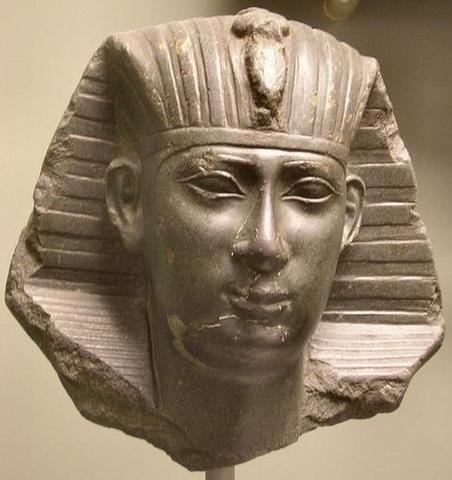Role Ruler Consort Istemabet Great grandchildren Psamtik II | Parents Tefnakht II Name Necho I Children Psamtik I | |
 | ||
Reign 672 – 664 BCE (26th Dynasty) Similar People Psamtik I, Necho II, Psamtik III, Apries, Amasis II | ||
Grandchildren Necho II, Nitocris I | ||
Menkheperre Necho I (Egyptian: Nekau, Greek: Νεχώς Α' or Νεχώ Α', Akkadian: Niku) (? – 664 BCE near Memphis) was a ruler of the Ancient Egyptian city of Sais. He was the first attested local Saite king of the 26th Dynasty of Egypt who reigned for 8 years (672–664 BCE) according to Manetho's Epitome. Egypt was reunified by his son Psamtik I.
Contents
Biography
In 672 BCE Necho became ruler of Sais, assuming the pharaonic titulary, and a year later the Assyrians led by Esarhaddon invaded Egypt. Necho became one of Esarhaddon's vassals, and the latter confirmed Necho's office and his possessions, as well as giving him new territories, possibly including the city of Memphis.
In 669 BCE, king Taharqa of the 25th Dynasty was advancing from the south toward the Nile Delta principalities which were formally under Assyrian control; once he was aware of that, Esarhaddon prepared himself to return to Egypt to repel the invader, but he died suddenly. Esarhaddon's death led to a political crisis in the Assyrian Empire but at the end his son Ashurbanipal managed to become the new undisputed monarch. The counteroffensive planned by his father took place in 667/666 BCE.
Taharqa was defeated and driven back to Thebes, but Ashurbanipal found that the fleeing king and some of the rulers of Lower Egypt – named Pekrur of Pishaptu (Per-Sopdu), Sharruludari of Ṣinu (maybe Pelusium) and Niku (Necho I) – were plotting against him. The Assyrian king captured the conspirators, killed part of the population of the cities they governed, and deported the prisoners to Nineveh.
Unexpectedly, Necho was pardoned by the Assyrian king, and was reinstated at Sais with his previous possessions as well as many new territories as a gift, while his son Psamtik (called Nabusezibanni in Akkadian) was made mayor of Athribis. It has been suggested that with his magnanimity Ashurbanipal hoped to rely on the loyalty of an Egyptian ally in the event of another offensive led by the 25th Dynasty pharaohs, and perhaps to inspire and strengthen a rivalry between the two families (i.e., Kushites and Saites) because of shared interests. According to historical records, Necho I was slain in 664 BCE near Memphis while defending his realms from a new Kushite offensive led by Taharqa's successor Tantamani while Psamtik fled to Nineveh under Ashurbanipal's aegis. This Nubian invasion into the Egyptian Delta was subsequently (664/663 BCE) repelled by the Assyrians who proceeded to advance south into Upper Egypt and performed the infamous sack of Thebes.
With the Nile Delta secured once again, Psamtik I was appointed with his dead father's offices and territories. Later, he ultimately was successful in reuniting Egypt under his sole control.
Family
Danish Egyptologist Kim Ryholt made claims regarding Necho I: studying a papyrus from Tebtunis, he stated that Necho I was the son of a king named Tefnakht, presumably Tefnakht II. Ryholt also put in discussion the existence of Nekauba who was the purported predecessor of Necho I and possibly his brother; Ryholt suggested that the few, dubious documents regarding Nekauba should be attributed to the later Necho II instead, and that Necho I was the direct successor of Tefnakht II.
French historian Christian Settipani believes that Necho married Istemabet, and they were the parents of Psamtik I and his sister.
According to British Egyptologist Kenneth Kitchen, it is possible that princess Ta-khered-en-ta-ihet-[weret] was Necho's daughter, given in a politically arranged marriage to the local ruler of Herakleopolis, Pediese.
Attestations
Necho I is primarily known from Assyrian documents but a few Egyptian objects are known too. Among these, a glazed pottery statuette of Horus which contains his cartouches and a dedication to the goddess Neith of Sais is now exhibited at the Petrie Museum of Egyptian Archaeology (UC 14869).
Necho I's Year 2 is now attested on a privately held donation stela that was first published by Olivier Perdu. The stela records a large land donation to the Osirian triad of Per-Hebyt (modern Behbeit el-Hagar near Sebennytos) by the "priest of Isis, Mistress of Hebyt, Great Chief... son of Iuput, Akanosh."
